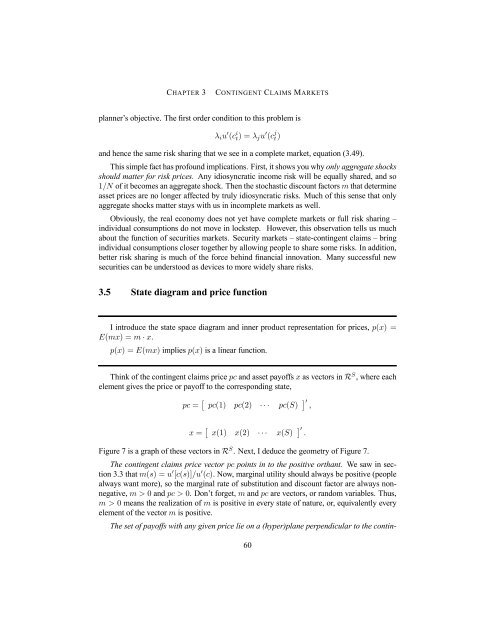Asset Pricing John H. Cochrane June 12, 2000
Asset Pricing John H. Cochrane June 12, 2000
Asset Pricing John H. Cochrane June 12, 2000
You also want an ePaper? Increase the reach of your titles
YUMPU automatically turns print PDFs into web optimized ePapers that Google loves.
CHAPTER 3 CONTINGENT CLAIMS MARKETS<br />
planner’s objective. The first order condition to this problem is<br />
λiu 0 (c i t)=λju 0 (c j<br />
t)<br />
and hence the same risk sharing that we see in a complete market, equation (3.49).<br />
This simple fact has profound implications. First, it shows you why only aggregate shocks<br />
should matter for risk prices. Any idiosyncratic income risk will be equally shared, and so<br />
1/N of it becomes an aggregate shock. Then the stochastic discount factors m that determine<br />
asset prices are no longer affected by truly idiosyncratic risks. Much of this sense that only<br />
aggregate shocks matter stays with us in incomplete markets as well.<br />
Obviously, the real economy does not yet have complete markets or full risk sharing –<br />
individual consumptions do not move in lockstep. However, this observation tells us much<br />
about the function of securities markets. Security markets – state-contingent claims – bring<br />
individual consumptions closer together by allowing people to share some risks. In addition,<br />
better risk sharing is much of the force behind financial innovation. Many successful new<br />
securities can be understood as devices to more widely share risks.<br />
3.5 State diagram and price function<br />
I introduce the state space diagram and inner product representation for prices, p(x) =<br />
E(mx) =m · x.<br />
p(x) =E(mx) implies p(x) is a linear function.<br />
Think of the contingent claims price pc and asset payoffs x as vectors in R S , where each<br />
element gives the price or payoff to the corresponding state,<br />
pc = £ pc(1) pc(2) ··· pc(S) ¤ 0 ,<br />
x = £ x(1) x(2) ··· x(S) ¤ 0 .<br />
Figure 7 is a graph of these vectors in R S . Next, I deduce the geometry of Figure 7.<br />
The contingent claims price vector pc points in to the positive orthant. We saw in section<br />
3.3 that m(s) =u 0 [c(s)]/u 0 (c). Now, marginal utility should always be positive (people<br />
always want more), so the marginal rate of substitution and discount factor are always nonnegative,<br />
m>0 and pc > 0. Don’t forget, m and pc are vectors, or random variables. Thus,<br />
m>0 means the realization of m is positive in every state of nature, or, equivalently every<br />
element of the vector m is positive.<br />
The set of payoffs with any given price lie on a (hyper)plane perpendicular to the contin-<br />
60
















